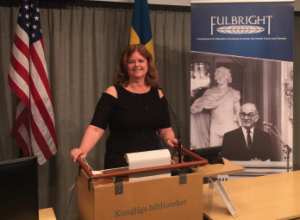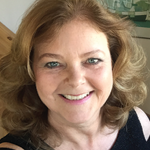
Dr. Maura Iversen was honored in a recognition ceremony at the Kunglia Biblioteket (the National Library of Sweden).
futuristman / shutterstock.com
A stroll through downtown Stockholm presents a quintessential picture of an active community, with most people biking or walking as their preferred mode of travel. Yet children in Sweden who live with juvenile idiopathic arthritis (JIA)—currently estimated at around 64 of every 100,000—don’t always engage in this active lifestyle.1 Maura Daly Iversen, PT, DPT, SD, MPH, FNAP, FAPTA, wants to know why.
Through a 2016–17 Fulbright Scholarship (the flagship international educational exchange program) she was awarded for research, Dr. Iversen is working in Sweden to investigate this issue. She is also engaged in several other studies in Sweden, including a study designed to determine how videos of patients can be used to more accurately assess physical function. Specifically, she examines how physicians and physical therapists can identify the presence of osteoarthritis (OA) through visual examination of movement patterns among patients with OA and healthy individuals.
As associate dean of clinical education, rehabilitation sciences and new initiatives in the Bouvé College of Health Sciences and professor in the department of physical therapy, Movement and Rehabilitation Sciences at Northeastern University in Boston, Dr. Iversen has spent the past decade investigating how activity interventions and outcome measures can improve disease management and overall health and well-being for adults living with rheumatic conditions. Her specific research has addressed such topics as validity and comprehensibility of current pediatric physical activity scales, perceptions of physical activity engagement among adults with rheumatoid arthritis (RA), comparative effectiveness of tai chi vs. physical therapy for knee osteoarthritis, how virtual reality games may improve mobility skills and balance measurements in community-dwelling older adults, and correlations of physical activity participation over three years in adults with RA.2-6

Dr. Iversen
Her goal with this work has been to help improve patient adherence to prescribed treatments, including physical therapy regimens and home activity, to achieve optimal health and mobility.
“Understanding how to help children with JIA optimize their physical activity has been the missing piece in my research,” she says.
Giving Pediatric Patients a Voice
Dr. Iversen believes that a focus on physical activity in Sweden can sometimes take a back seat to medication regimens and other attempts to reduce disease activity similar to the focus of children and adolescents in the U.S. who live with JIA. Dialing in the right approach to physical activity is an equally important aspect of treating JIA to reduce the risk for cardiovascular complications down the road. “It can also make a difference in helping these children gain physical confidence as they grow up with the disease,” Dr. Iversen stresses.

